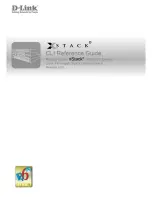
2-9
Static Virtual LANs (VLANs)
Port-Based Virtual LANs (Static VLANs)
General Steps for Using VLANs
1.
Plan your VLAN strategy and create a map of the logical topology that will
result from configuring VLANs. Include consideration for the interaction
between VLANs and other features such as Spanning Tree Protocol, load
balancing, and IGMP. (Refer to “Effect of VLANs on Other Switch Fea-
tures” on page 2-34.) If you plan on using dynamic VLANs, include the port
configuration planning necessary to support this feature. (See chapter 3,
“GVRP”.)
By default, VLAN support is enabled and the switch is configured for eight
VLANs.
2.
Configure at least one VLAN in addition to the default VLAN.
3.
Assign the desired switch ports to the new VLAN(s).
4.
If you are managing VLANs with SNMP in an IP network, each VLAN must
have an IP address. Refer to the chapter on IP addressing in the
Manage-
ment and Configuration Guide
.
VLAN Operating Notes
■
If you are using DHCP/Bootp to acquire the switch’s configuration, packet
time-to-live, and TimeP information, you must designate the VLAN on
which DHCP is configured for this purpose as the primary VLAN. (In the
factory-default configuration, the DEFAULT_VLAN is the primary VLAN.)
■
IGMP, and some other features operate on a “per VLAN” basis. This means
you must configure such features separately for each VLAN in which you
want them to operate.
■
You can rename the default VLAN, but you cannot change its VID (1) or
delete it from the switch.
■
Any ports
not
specifically assigned to another VLAN will remain assigned
to the DEFAULT_VLAN.
■
To delete a VLAN from the switch, you must first remove from that VLAN
any ports assigned to it.
■
Changing the number of VLANs supported on the switch requires a reboot.
Other VLAN configuration changes are dynamic.
Multiple VLAN Considerations
Switches use a
forwarding database
to maintain awareness of which external
devices are located on which VLANs. Some switches, such as those covered
by this guide, have a
multiple-forwarding database
, which means the switch
allows multiple database entries of the same MAC address, with each entry
Summary of Contents for ProCurve 2810-24G
Page 1: ...Advanced Traffic Management Guide 2810 www procurve com ProCurve Series 2810 Switches N 11 XX ...
Page 2: ......
Page 3: ...ProCurve Series 2810 Switches Advanced Traffic Management Guide July 2007 ...
Page 11: ...ix Web Viewing and Configuring Stacking 7 47 Status Messages 7 48 Index ...
Page 12: ...x ...
Page 76: ...3 18 GVRP Introduction ...
Page 271: ......
















































